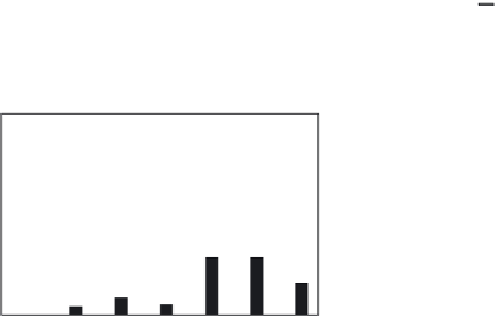Geoscience Reference
In-Depth Information
Øvre Neadalsvatn
Lake Redon
25
25
T
= 3.6°C
T
= 2.5°C
20
20
15
15
10
10
5
5
0
0
28
52
101
118
138
153
180
28
52
101
118
138
153
180
PCB congeners
PCB congeners
Gossenköllesee
25
T
= 0.5°C
20
15
10
5
0
28
52
101
118
138
153
180
PCB congeners
Figure 8.7
Comparison of the atmospheric deposition (dotted bars) and sedimentation
flows of PCB congeners in high-mountain lakes (solid bars). Greater flows of
atmospheric precipitation are observed for the lower molecular weight (i.e. most
volatile) compounds, whereas sedimentation primarily affects the higher molecular
weight (i.e. least volatile) compounds. This phenomenon is most pronounced in the
coldest lake (Gossenköllesee). (Based on Carrera
et al
. 2002.)
compounds and at the site of lowest temperature (Skalnate Pleso). Such seasonal
differences in concentration are consistent with the observations on atmospheric
deposition. Accordingly, one of the direct consequences of climatic change will
likely be an increase in atmospheric concentration of these compounds and,
consequently, greater contamination of organisms, including humans.
The altitudinal accumulations of these compounds have toxic effects on the
organisms living in these remote sites. Some of these effects have been identified
by examination of cytochrome P450 1A (Cyp1A). This enzyme is an established
biomarker of oxidative exposure to different environmental pollutants in many
animal species, including fish (van der Oost
et al
. 2003). Expression of Cyp1A
increases upon exposure to the so-called dioxin-like compounds, which include a
variety of recognized pollutants, such as dioxins, coplanar PCBs and PAH, among
others (Fent 2003). The effect on Cyp1A expression can be detected by measuring
the levels of the corresponding RNA messenger (mRNA) (Piña
et al
. 2007).
The variability of hepatic Cyp1A gene expression levels in brown trout (
Salmo
trutta
) populations from 11 European mountain lakes (101 individuals analysed) is
















































































Search WWH ::

Custom Search